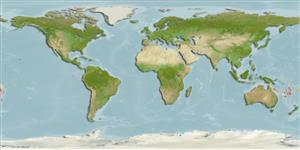Classification / Names
Nombres comunes | Sinónimos | Catalog of Fishes(Género, Especie) | ITIS | CoL | WoRMS | Cloffa
Environment: milieu / climate zone / depth range / distribution range
Ecología
marino batidemersal; rango de profundidad 250 - 320 m (Ref. 28982). Deep-water
Western Pacific: New Caledonia.
Tamaño / Peso / Age
Maturity: Lm ? range ? - ? cm
Max length : 13.3 cm SL macho / no sexado; (Ref. 28982); 11.3 cm SL (female)
Mouth small, upper-jaw length on eyed side 2.8 to 3.1 times in head length. Pectoral fin on eyed side much less than head length in both sexes. Body comparatively deep. Maximum SL about 12.1 cm (Ref 42535).
Life cycle and mating behavior
Maturities | Reproducción | Spawnings | Egg(s) | Fecundities | Larva
Amaoka, K., E. Mihara and J. Rivaton, 1997. Pisces, Pleuronectiformes: Flatfishes from the waters around New Caledonia. Six species of the bothid genera Tosarhombus and Parabothus. p.144-171. In B. Séret (ed.) Résultats des Campagnes MUSORTOM,17, Mém. Mus. Natn. Hist. Nat. 174, 212p. (Ref. 28982)
IUCN Red List Status (Ref. 130435)
Threat to humans
Harmless
Human uses
Herramientas
Special reports
Download XML
Fuentes de Internet
Estimates based on models
Preferred temperature (Ref.
123201): 6.4 - 9, mean 8.6 °C (based on 7 cells).
Phylogenetic diversity index (Ref.
82804): PD
50 = 0.5156 [Uniqueness, from 0.5 = low to 2.0 = high].
Bayesian length-weight: a=0.00912 (0.00408 - 0.02036), b=3.05 (2.87 - 3.23), in cm total length, based on LWR estimates for this (Sub)family-body shape (Ref.
93245).
Nivel trófico (Ref.
69278): 3.5 ±0.4 se; based on size and trophs of closest relatives
Resiliencia (Ref.
120179): Medio, población duplicada en un tiempo mínimo de 1.4-4.4 años (Assuming tmax>3).
Fishing Vulnerability (Ref.
59153): Low vulnerability (10 of 100).
